
Principles and Applications of Asymmetric Synthesis
.pdf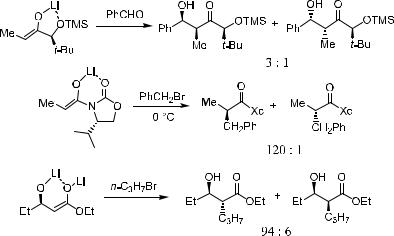
80 a-ALKYLATION AND CATALYTIC ALKYLATION OF CARBONYL COMPOUNDS
Scheme 2±11. Chelation-enforced intra-annular chirality transfer.
Much attention has been devoted to the examination of chiral enolate systems in which metal ion chelation may play an important role in establishing a ®xed stereochemical relationship between the resident chirality and the enolate moiety. This has resulted in the conclusion that enolate geometry is critical in the de®nition of p-facial selection. The following sections discuss this e¨ort in several di¨erent chemical systems.
2.2.3.1b-Hydroxy Acid Systems. The alkylation of b-hydroxy ester enolates is an excellent example of a reaction in which metal chelation plays a critical role.21 In this system, two points should be taken into consideration. First, in the enolization process these substrates may form either (E )- or (Z)- enolates; second, from either of these enolate systems, chelation could be involved in determining the enolate-facial selection. As shown in Scheme 2±12, the major component of the reaction product is formed as a result of Re-face attack on the (Z)- or (E )-enolate.
The enolization product depends on the structure of the carbonyl substrate: When b-OH is present in the carbonyl compound, (Z)-enolate is the major product due to the metal ion chelation,20c whereas (E )-enolate is the major product in the absence of a b-OH group.22 It is worth noting that the yield is normally low for b-OH carbonyl substrates because of the tendency for b- elimination.
Generally speaking, if care is taken, alkylation of b-hydroxyl esters can be successful (Scheme 2±13).21a,f
2.2.3.2Prolinol-Type Chiral Auxiliaries. In this section, applications of chelation-enforced chirality transfers with nitrogen derivatives are discussed
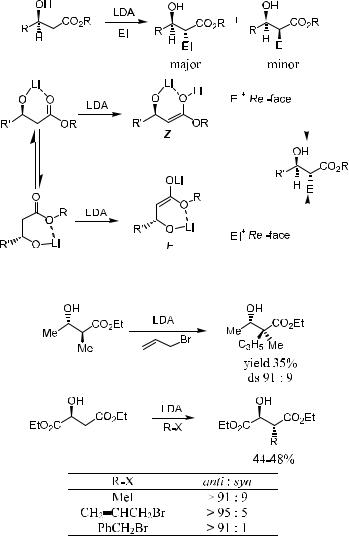
|
2.2 CHIRALITY TRANSFER |
81 |
||||||||||
|
|
|
|
|
|
|
|
|
|
|
|
|
|
|
|
|
|
|
|
|
|
|
|
|
|
|
|
|
|
|
|
|
|
|
|
|
|
|
|
|
|
|
|
|
|
|
|
|
|
|
|
|
|
|
|
|
|
|
|
|
|
|
|
|
|
|
|
|
|
|
|
|
|
|
|
|
|
|
|
|
|
|
|
|
|
|
|
|
|
|
|
|
|
|
|
|
|
|
|
|
|
|
|
|
|
|
|
|
|
|
|
|
|
|
|
|
|
|
|
|
|
|
|
|
|
|
|
|
|
|
|
|
|
|
|
|
|
|
|
|
|
|
|
|
|
|
|
|
|
|
|
|
|
|
|
|
|
|
|
|
|
|
|
|
|
|
|
|
|
|
|
|
|
|
|
|
|
|
|
|
|
|
|
|
|
|
|
|
|
|
|
|
|
|
|
|
|
|
|
|
|
|
|
|
|
|
|
|
|
|
|
|
|
|
|
|
|
|
|
|
Scheme 2±12
Scheme 2±13. Diastereoselective alkylation of b-hydroxy enolates.
brie¯y. The formation of nitrogen derivatives, such as chiral imines, imides, amides, and sultams or other nitrogen analogs, from ketones or acids allows the incorporation of a chiral auxiliary that can be removed through hydrolysis or reduction after alkylation. These chiral enolates provide the entry into a- substituted ketones, carboxylic acids, and other related compounds.
Evans and Takacs23 demonstrated a diastereoselective alkylation based on metal ion chelation of a lithium enolate derived from a prolinol-type chiral auxiliary. This method can provide e¨ective syntheses of a-substituted carbox-
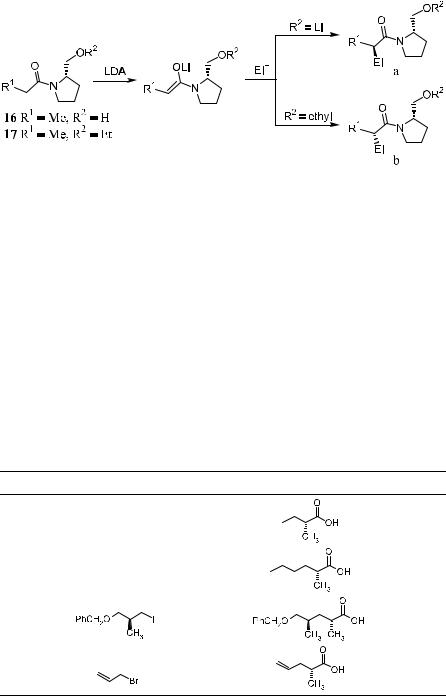
82 a-ALKYLATION AND CATALYTIC ALKYLATION OF CARBONYL COMPOUNDS
Scheme 2±14
ylic acids. The alkylation occurs preferentially from the Si-face of the enolate system 16 (R1 ˆ Me, R2 ˆ H) or Re-face of 17 (R1 ˆ Me, R2 ˆ Et). The sense of asymmetric induction is strongly in¯uenced by the nature of the pendent oxygen substituent R2. When R2 is lithium, preferential alkylation from the Siface of the enolate can be found, whereas the analogous alkylation reaction of the derived ethers exhibited a reversal in p-selection. Thus, starting from either substrate 16 or 17, a pair of enantiomers of the ®nal a-substituted carboxylic acids can be obtained after acidic hydrolysis of the alkylated product (Scheme 2±14). Table 2±3 shows the results of the enantioselective alkylation of 16, indicating that a-alkylated carboxylic acid can be obtained upon hydrolysis of the reaction product.
In this reaction, prolinol serves as a chiral auxiliary, but it cannot be easily
TABLE 2±3. Enantioselective Alkylations and Conversions of 16 to Carboxylic Acids23
Entry |
Electrophile |
a:b |
Hydrolysis products |
Yield (%) |
1 |
CH3CH2I |
92:8 |
|
84 |
2 |
n-C4H9I |
94:6 |
|
78 |
3 |
|
97:3 |
|
91 |
4 |
|
96:4 |
|
87 |
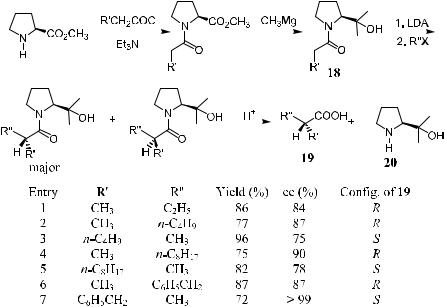
|
|
|
|
|
|
|
|
|
|
2.2 CHIRALITY TRANSFER |
83 |
|||||
|
|
|
|
|
|
|
|
|
|
|
|
|
|
|
|
|
|
|
|
|
|
|
|
|
|
|
|
|
|
|
|
|
|
|
|
|
|
|
|
|
|
|
|
|
|
|
|
|
|
|
|
|
|
|
|
|
|
|
|
|
|
|
|
|
|
|
|
|
|
|
|
|
|
|
|
|
|
|
|
|
|
|
|
|
|
|
|
|
|
|
|
|
|
|
|
|
|
|
|
|
|
|
|
|
|
|
|
|
|
|
|
|
|
|
|
|
|
|
Scheme 2±15
recovered from the reaction mixture due to its high water solubility. To overcome this problem, Lin et al.24 modi®ed Evans' reagent by introducing two methyl groups to prolinol to form a tertiary alcohol 18, which can easily be recovered after the workup. By changing the reaction sequence of R and R0 in the acyl and alkyl groups, both of the enantiomers of the carboxylic acid can be obtained (Scheme 2±15).
In the development of asymmetric synthesis methodology, the advantage of a chiral auxiliary having C2 asymmetry has been realized and applied to the pyrrolidines, a prolinol structure±based derivative.25 The asymmetric alkylation of the corresponding carboxylamide enolates developed by Kawanami et al.26 has proved to be highly successful in providing good chemical yield and high enantioselectivity.
Racemic trans-N-benzyl-2,5-bis-(ethoxycarbonyl)pyrrolidine has been resolved via its dicarboxylic acid, followed by subsequent transformation to o¨er (2R,5R)-21 or (2S,5S)-21. The absolute con®guration of the alkylated carboxylic acids indicates that the approach of alkyl halides is directed to one of the diastereotopic faces of the enolate thus formed. In the following case, the approached face is the Si-face of the (Z)-enolate. By employing the chiral auxiliary (2R,5R)-21 or its enantiomer (2S,5S)-21, the (R)- or (S)-form of carboxylic acids can be obtained with considerably high enantioselectivity (Table 2±4).
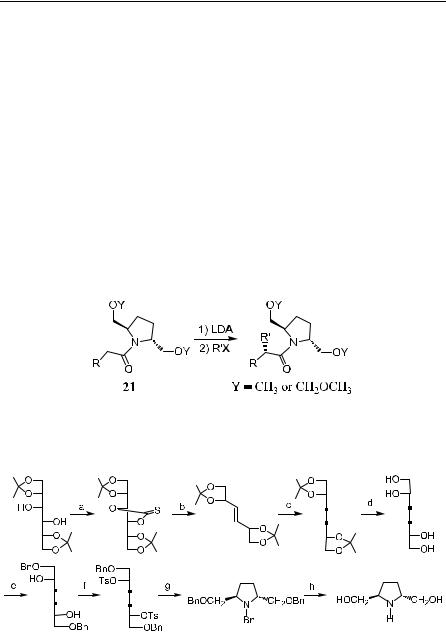
84 a-ALKYLATION AND CATALYTIC ALKYLATION OF CARBONYL COMPOUNDS
TABLE 2±4. Asymmetric Alkylation Using (2R,5R)-21 in THF at ÿ78 C
|
R in 21 Y ˆ CH3 |
|
Yield |
de |
|
Entry |
R0X |
(%) |
(%) |
Con®guration* |
|
1 |
CH3 |
C2H5I |
87 |
>95 |
R |
2 |
CHy |
C2H5I |
78 |
>95 |
S |
|
3 |
|
|
|
|
3 |
C2H5 |
CH3I |
91 |
>95 |
S |
4 |
CH3 |
C4H9I |
81 |
>95 |
(R) |
5 |
C4H9 |
CH3I |
81 |
>95 |
(S) |
6 |
CH3 |
PhCH2Br |
80 |
>95 |
R |
7 |
PhCH2 |
CH3I |
76 |
>95 |
S |
8 |
C16H33 |
CH3I |
61 |
>95 |
(S) |
9 |
CH3 |
CH2 bCHCH2Br |
81 |
>95 |
(R) |
10 |
CH3 |
PhCH2OCH2Cl |
74 |
>95 |
(R) |
11 |
CH3 |
R00OCH2CH2CH2Brz |
78 |
>95 |
(R) |
* Tentative assignment in parentheses. Reprinted with permission by Pergamon Press Ltd., Ref. 26. y (2S,5S)-enantiomer of 21 was used.
z R00 ˆ TBS.
de ˆ diastereometric excess.
The chiral auxiliary trans-(2R,5R)-bis-(benzyloxymethyl)pyrrolidine can be prepared from mannitol as shown in Scheme 2±1627:
Scheme 2±16. Synthesis of pyrrolidine. Reagents and conditions: a: TCDI (1,1-thiono- carbonyldiimidazole), THF; b: P(OEt)3, DEAD; c: H2, Rh/Al2O3, EtOH; d: TsOH, aq. MeOH; e: Bu2SnO, toluene, re¯ux; BnBr, Bu4N‡Brÿ; f: TsCl, Py, 0 C; g: BnNH2, D; h: H2, Pd(OH)2/C, EtOH.

2.2 CHIRALITY TRANSFER |
85 |
TABLE 2±5. Diastereoselective Alkylation Reaction of the Lithium Enolates Derived from Imides 22 and 23
Entry |
|
Imide |
EI‡ |
Ratio |
Yield (%) |
1 |
22 |
(R ˆ CH3) |
PhCH2Br |
99:1 |
92 |
2 |
23 |
(R ˆ CH3) |
PhCH2Br |
2:98 |
78 |
3 |
22 |
(R ˆ C2H5) |
CH3I |
89:11 |
79 |
4 |
23 |
(R ˆ C2H5) |
CH3I |
13:87 |
82 |
5 |
22 |
(R ˆ CH3) |
C2H5I |
94:6 |
36 |
6 |
23 |
(R ˆ CH3) |
C2H5I |
12:88 |
53 |
7 |
22 |
(R ˆ CH3) |
CH2 bCHCH2Br |
98:2 |
71 |
8 |
23 |
(R ˆ CH3) |
CH2 bCHCH2Br |
2:98 |
65 |
EI‡ ˆ electrophiles in Scheme 2±17.
Reprinted with permission by Am. Chem. Soc., Ref. 28.
2.2.3.3 Imide Systems. Imide compounds 22 and 23, or Evans' reagents, derived from the corresponding oxazolidines are chiral auxiliaries for e¨ective asymmetric alkylation or aldol condensation and have been widely used in the synthesis of a variety of substances.
Table 2±5 summarizes the results of the asymmetric alkylation (Scheme 2± 17) of the lithium enolates derived from 22 or 23.28 When chiral auxiliary 22 or 23 is involved in the alkylation reactions, the substituent at C-4 of the oxazolidine ring determines the stereoselectivity and therefore controls the stereogenic outcome of the alkylation reaction.
Scheme 2±17

86 a-ALKYLATION AND CATALYTIC ALKYLATION OF CARBONYL COMPOUNDS
The application of Evans' imides in the preparation of various alkyl acids or the corresponding derivatives can be depicted as in Scheme 2±1829:
Scheme 2±18
The main disadvantages of Evans' auxiliaries 22 and 23 are that they are expensive to purchase and inconvenient to prepare, as the preparation involves the reduction of (S)-valine 24 to water-soluble (S)-valinol, which cannot be readily extracted to the organic phase. The isolation of this water-soluble valinol is di½cult and requires a high vacuum distillation, which is not always practical, especially on an industrial scale. Therefore, an e½cient synthesis of Evans' chiral auxiliary 25 has been developed, as depicted in Scheme 2±1930:
Scheme 2±19. Synthesis of Evans' chiral auxiliary 25.
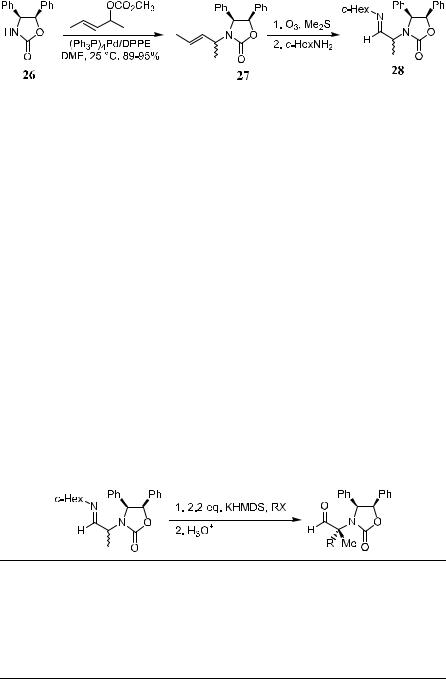
2.2 CHIRALITY TRANSFER |
87 |
Scheme 2±20
This imide system can also be used for the asymmetric synthesis of optically pure a,a-disubstituted amino aldehydes, which can be used in many synthetic applications.31 These optically active a-amino aldehydes were originally obtained from naturally occurring amino acids, which limited their availability. Thus, Wenglowsky and Hegedus32 reported a more practical route to a-amino aldehydes via an oxazolidinone method. As shown in Scheme 2±20, chiral diphenyl oxazolidinone 26 is ®rst converted to allylic oxazolidinone 27; subsequent ozonolysis and imine formation lead to compound 28, which is ready for the a-alkylation using the oxazolidinone method. The results are shown in Table 2±6.
2.2.3.4 Chiral Enamine Systems. At this stage it is appropriate to introduce some important studies in the ®eld of metalloenamines. To start with, note that metalloenamine generated from chiral cyclohexanone imine 29 or 31 is highly diastereoselective in alkylation (Scheme 2±21 and the results therein).33 This can be explained by the possible transition states. If we take 29 as an example, there is an equilibrium between two possible transition states as shown in Figure 2±1. It appears that the left structure is more stable than the right one, thus favoring the formation of the product 30 in (R)-con®guration.
TABLE 2±6. Synthesis of a-Amino Aldehydes
Entry |
RX |
de |
Yield (%) |
|
|
|
|
1 |
PhCH2Br |
94:6 |
62 |
2 |
3,4-di-MeOPhCH2Br |
90:10 |
47 |
3 |
CH2 bCHCH2Br |
92.5:7.5 |
62 |
4 |
(CH3)2CHCH2I |
93.5:6.5 |
62 |
5 |
(CH3)2CHI |
97.5:2.5 |
48 |
6 |
n-BuI |
92:8 |
75 |
de ˆ diastereomeric excess; RX ˆ electrophiles in the reaction.
Reprinted with permission by Am. Chem. Soc., Ref. 32.
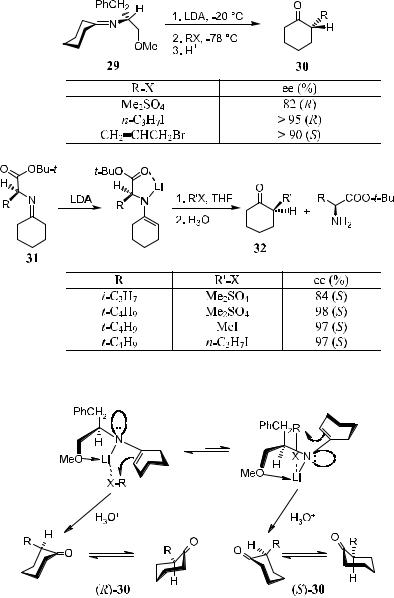
88 a-ALKYLATION AND CATALYTIC ALKYLATION OF CARBONYL COMPOUNDS
Scheme 2±21
Figure 2±1. Transition state for a-alkylation of enamines.
2.2.3.5 Chiral Hydrazone Systems. In 1976, Corey and Enders34 demonstrated the great synthetic potential of metalated dimethylhydrazones as highly reactive intermediates in regioand diastereoselective C±C bond formation reactions. The procedure for carrying out the electrophilic substitution reaction
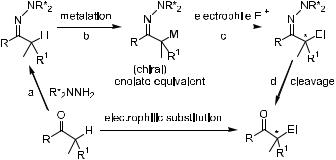
|
2.2 CHIRALITY TRANSFER |
89 |
|||
|
|
|
|
|
|
|
|
|
|
|
|
|
|
|
|
|
|
Figure 2±2. Electrophilic substitution to the carbonyl group of aldehydes and ketones via metalated (chiral) hydrazones.
at the a-carbon of the carbonyl group is shown in Figure 2±2. The carbonyl compounds are metalated to give enolate equivalents, which can be trapped with electrophiles. As indicated in Figure 2±2, if one uses an achiral ketone and chiral hydrazine in step a, this will be a chiral version of the hydrazone method, and chiral substituted ketone will be the ®nal product.
Alkylation of chiral hydrazones has several advantages. The starting hydrazones can be conveniently prepared, even for sterically hindered ketones. The product thus formed is highly stable, and its metalated derivative has very high reactivity. The subsequent electrophilic substitution reaction will give very good yield, and a variety of procedures are available to remove the hydrazine moiety and to release the ®nal alkylated product.35 For example, the hydrazine moiety can be removed through a very mild oxidation of the alkylation product under neutral conditions (pH ˆ 7). The reaction can be carried out with the corresponding cuprates, which are readily available as well.
Enders developed the ``hydrazone methods'' by choosing SAMP and its enantiomer RAMP. The application and scope of SAMP/RAMP are summarized in Figure 2±3. SAMP and RAMP can be prepared on a large scale from (S)-proline36 and (R)-glutamic acid,37 respectively.
A good example of applying the hydrazone method is the preparation of the optically active pheromone 34 (Scheme 2±22).38 Further study of the crude product prepared from SAMP-hydrazone and 3-pentanone 33 shows that, among the four possible stereoisomers, (Z,S,S)-isomer 35 predominates along with the minor (E,S,S)-isomer, the geometric isomer of 35. The ®nal product 34 was obtained with over 97% enantiomeric excess (ee).
It has been reported that the cleavage of SAMP hydrazones can proceed smoothly with a saturated aqueous oxalic acid, and this allows the e½cient recovery of the expensive and acid-sensitive chiral auxiliaries SAMP and RAMP. No racemization of the chiral ketones occurs during the weak acid oxalic acid treatment, so this method is essential for compounds sensitive to oxidative cleavage.39a
